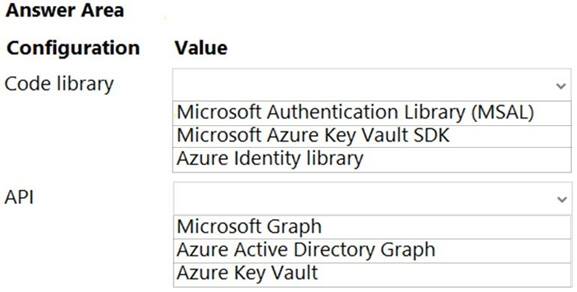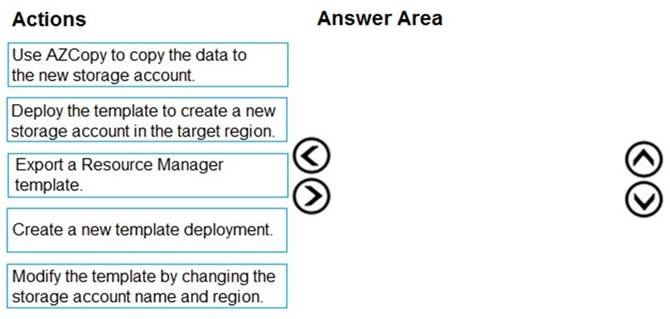- (Topic 8)
You develop and deploy an Azure App Service web app to a production environment. You enable the Always On setting and the Application Insights site extensions. You deploy a code update and receive multiple failed requests and exceptions in the web app. You need to validate the performance and failure counts of the web app in near real time. Which Application Insights tool should you use?
Correct Answer:
D
HOTSPOT - (Topic 8)
You need to implement the Azure Function for delivery driver profile information.
Which configurations should you use? To answer, select the appropriate options in the answer area.
NOTE: Each correct selection is worth one point.
Solution:
Code Library: MSAL API: Microsoft Graph
https://docs.microsoft.com/en-us/azure/active-directory/develop/msal-overview
Does this meet the goal?
Correct Answer:
A
DRAG DROP - (Topic 8)
You develop an Azure solution that uses Cosmos DB.
The current Cosmos DB container must be replicated and must use a partition key that is optimized for queries.
You need to implement a change feed processor solution.
Which change feed processor components should you use? To answer, drag the appropriate components to the correct requirements. Each component may be used once, more than once, or not at all. You may need to drag the split bar between panes or scroll to view the content.
NOTE:Each correct selection is worth one point.
Solution:
Box 1: The monitored container
The monitored container has the data from which the change feed is generated. Any inserts and updates to the monitored container are reflected in the change feed of the container.
Box 2: The lease container
The lease container acts as a state storage and coordinates processing the change feed across multiple workers. The lease container can be stored in the same account as the monitored container or in a separate account.
Box 3: The host: A host is an application instance that uses the change feed processor to listen for changes. Multiple instances with the same lease configuration can run in parallel, but each instance should have a different instance name.
Box 4: The delegate
The delegate is the code that defines what you, the developer, want to do with each batch of changes that the change feed processor reads.
Does this meet the goal?
Correct Answer:
A
DRAG DROP - (Topic 8)
You are developing a solution for a hospital to support the following use cases:
•The most recent patient status details must be retrieved even if multiple users in different locations have updated the patient record.
•Patient health monitoring data retrieved must be the current version or the prior version.
•After a patient is discharged and all charges have been assessed, the patient billing record contains the final charges.
You provision a Cosmos DB NoSQL database and set the default consistency level for the database account to Strong. You set the value for Indexing Mode to Consistent.
You need to minimize latency and any impact to the availability of the solution. You must override the default consistency level at the query level to meet the required consistency guarantees for the scenarios.
Which consistency levels should you implement? To answer, drag the appropriate consistency levels to the correct requirements. Each consistency level may be used once, more than once, or not at all. You may need to drag the split bar between panes or scroll to view content.
NOTE: Each correct selection is worth one point.
Solution:
Box 1: Strong
Strong: Strong consistency offers a linearizability guarantee. The reads are guaranteed to return the most recent committed version of an item. A client never sees an uncommitted or partial write. Users are always guaranteed to read the latest committed write.
Box 2: Bounded staleness
Bounded staleness: The reads are guaranteed to honor the consistent-prefix guarantee. The reads might lag behind writes by at most "K" versions (that is "updates") of an item or by "t" time interval. When you choose bounded staleness, the "staleness" can be configured in two ways:
The number of versions (K) of the item
The time interval (t) by which the reads might lag behind the writes
Box 3: Eventual
Eventual: There's no ordering guarantee for reads. In the absence of any further writes, the replicas eventually converge.
Does this meet the goal?
Correct Answer:
A
DRAG DROP - (Topic 8)
You are developing an application to use Azure Blob storage. You have configured Azure Blob storage to include change feeds.
A copy of your storage account must be created in another region. Data must be copied from the current storage account to the new storage account directly between the storage servers.
You need to create a copy of the storage account in another region and copy the data.
In which order should you perform the actions? To answer, move all actions from the list of actions to the answer area and arrange them in the correct order.
Solution:
https://docs.microsoft.com/en-us/azure/storage/common/storage-account-move?tabs=azure-portal#modify-the-template
Does this meet the goal?
Correct Answer:
A

